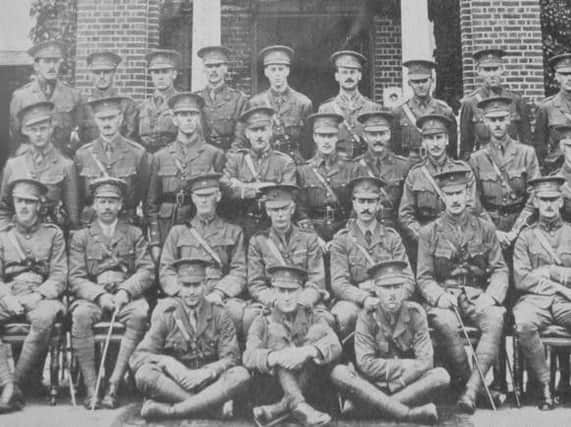Village cricket heroes who made the ultimate sacrifice


We have a family connection to the village in that our daughter, Helen, and son-in-law, Stuart Mouland, now live there with their three young daughters, Jessica, Sienna and little Annie. Stuart keeps wicket for the Ringmer cricket team who have just completed a successful season in the East Sussex Cricket League Division One. So you should not be surprised that my interest was at once aroused when I spotted references to Ringmer cricketers in Mr. Bridger’s book.
There is a stone tablet in the village church of St. Mary The Virgin that honours 28 members of the cricket club who “joined the Colours” as volunteers in World War One. The tablet goes on to record how three of them died “fighting victoriously” and after listing their names proudly proclaims that “They played the game”.
Advertisement
Hide AdAdvertisement
Hide AdThese days such words might jar as a bit jingoistic. But in the time of the Great War, British fair play in sport was often highlighted to demonstrate a moral superiority over the enemy. Patriotic female war poet Jessie Pope unashamedly featured sporting analogies in her work. Here’s an example:
“Our cricketers have gone ‘on tour’,
To make their country’s triumph sure.
They’ll take the Kaiser’s middle wicket
And smash it by clean British cricket.”
First name on the tablet is that of Captain Edward Hubert Charles Drouet Le Marchant. He had a family link to Glynde but served (as had his father) in the Hampshire Regiment. He died aged 22 on 29th October 1916 from wounds inflicted six days earlier during the Battle of the Somme.
Remember Bill Shankly’s famous remark about football being more serious than a matter of life and death? Well maybe he chose the wrong sport. I say this because Wisden (of Almanack fame) maintained a list of notable Great War cricketing casualties. For public schoolboy Edward they recorded: Captain Le Marchant “… was in the Harrow Eleven in 1913, being a useful batsman and bowler. Against Eton he scored 14 and took one wicket for 34 runs.”
Frank Miles Wilmshurst is also named on the tablet. He joined the Royal Sussex Regiment in March 1916 and was sent to France eight weeks later. In August 1917 he was hospitalized after a poison gas attack and several weeks later was grievously wounded in a bombing raid. On 22nd September, aged 20, Private Wilmshurst died. He is buried in Dozinghem Military Cemetery in Belgium. The tablet was funded by Frank’s father, William, proprietor of the village Post Office.
Advertisement
Hide AdAdvertisement
Hide AdThe third cricketer was Private Clifford John Andrew of the 5th (Cinque Ports) Battalion of the Royal Sussex Regiment. He was killed along with two Ringmer friends, Arthur Moore and George Waller, at the Battle of Aubers Ridge on 9th May 1915. Clifford had a cricketing brother, George, who was wounded and taken prisoner in the same action.
The Second World War saw Ringmer Cricket Club suffer the loss of another player. Redvers C. M. Parris was born in November 1920. He was educated at Ringmer School and was always destined to turn out for the village team not least because his grandfather was the professional cricketer Frederick “Fergie” Parris who played for Sussex. In a match with Gloucestershire he twice bowled out the legendary W. G. Grace. An evidently impressed Grace bought the bowler a £20 gold watch engraved in celebration of his sporting prowess.
Redvers joined the RAF in 1940 and became a gunner in Wellington bombers. His squadron (215) was posted to Jessore in India and went into action against the Japanese in Burma. On 29th July 1943 his aircraft was on a reconnaissance patrol along the Arakan Coast when it was shot down by a Japanese fighter plane. At first it was thought the entire crew of the Wellington had perished but then all bar one were found alive on a remote island that they had reached by dinghy. The missing crewman was Redvers Parris who was unable to escape from his cramped gun turret before the aircraft sank in the Bay of Bengal. With no known grave, Sergeant Parris is commemorated on the Singapore Memorial.
“Valiant Hearts of Ringmer” has a foreword by former British Premier, Jim Callaghan, who lived in retirement on a farm near the village. He wrote: “I express our thanks to Geoffrey Bridger and our hope that never again shall we have occasion to carve the names of a third generation of Ringmer men and women on the simple stone monument that is a permanent reminder to us of the tragedy and waste of war.”
Advertisement
Hide AdAdvertisement
Hide AdLike Redvers Parris, Callaghan also served in the Far East. He was there with the Royal Navy towards the end of the war. Callaghan’s own contribution to cricketing history came in 1970 when, as Home Secretary, he persuaded the game’s authorities to cancel a UK tour by a South African team because of that country’s apartheid regime.
Oddly enough, in the 1964 general election the Tory opponent for his Cardiff seat was none other than celebrated batsman and bowler Ted Dexter. Callaghan was re-elected with a greatly increased majority. This was around the time the somewhat haughty “Lord Ted” was Captain of Sussex and England.